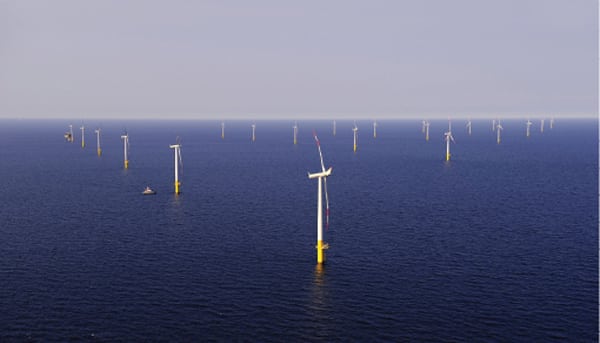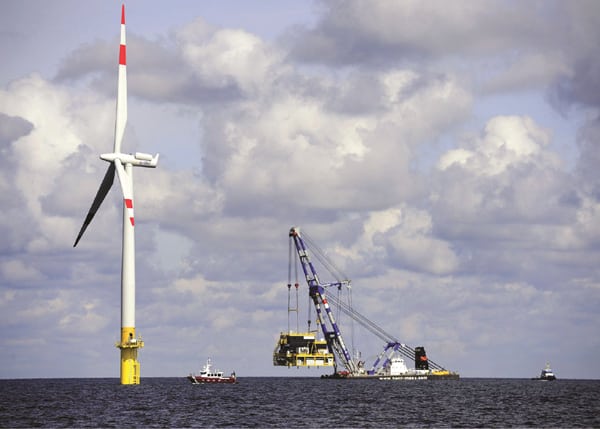Top Plant: EnBW Baltic 1, Darss-Zingst Peninsula, Mecklenburg Province, Germany
Owner/operator: EnBW Energie Baden-Württemberg AG/EnBW Renewables GmbH
Germany’s first commercial offshore wind farm—the 48.3-MW EnBW Baltic 1—consists of 21 Siemens wind turbines, each with a capacity of 2.3 MW and a rotor diameter of 93 meters. Siemens constructed the facility in an area covering about 7 square kilometers in the Baltic Sea.
 |
| Courtesy: Siemens |
Providing a reliable power supply from offshore wind turbines can be daunting because, typically, winds at sea are much stronger than onshore winds. Consequently, the logistics of installing ocean wind energy facilities and connecting them to the grid are much more challenging than carrying out similar operations on land. Despite such hurdles, Siemens recently completed successful installation of EnBW Baltic 1, an offshore wind farm located in the Baltic Sea approximately 16 kilometers (km or 9.94 miles) north of the Darss-Zingst peninsula.
The project, owned by EnBW Energie Baden Württemberg (EnBW), the third-largest energy company in Germany, was officially put into operation in May 2011. (A 60-MW offshore “pilot” project went into operation in late 2009. See our Feb. 2010 Global Monitor for coverage.) The wind farm’s electricity is transformed at the project’s transformer platform from 33 kV to 150 kV; the transformer is connected to the land grid by the company 50Hertz Offshore GmbH. With a projected output of approximately 185 GWh a year, the project will supply more than 50,000 German households with clean energy.
“This is an important milestone in the use of German offshore wind power. Onshore, Germany was a pioneer in wind power—and now it’s important to rapidly tap the huge offshore potential,” said René Umlauft, CEO of the Renewable Energy Division at Siemens, in May. He projected that by 2030, wind farms with total capacity between 20,000 MW and 25,000 MW will be operating off Germany’s coasts and delivering electricity to German customers.
He added, “We’ll soon be introducing a new wind turbine with a capacity of six megawatts.” The new turbine will be gearless and well-suited for offshore wind farms.
The German Energy Sector
It’s not surprising that Germany is a world leader in the use of wind power. In recent years, the country has aggressively promoted the use of renewable energy through its governmental policies. For example, on December 5, 2007, the German government unveiled its Integrated Energy and Climate Program, which aims to set a global example in the fields of energy and climate policy and is suited to the needs and capabilities of a modern national economy, according to the German Federal Ministry of Economics and Technology. The launch was timed to coincide with the kick-off of the United Nations Climate Change Conference in Bali, which was held in December 2007.
The program is based on the conviction that energy must be used with much greater efficiency than is currently the case and that much higher priority must be placed on the use of low-carbon energy.
The adopted measures aim to prove that climate protection is both affordable and compatible with economic growth. For this reason, the German government is pursuing policies that deliver favorable results in keeping carbon dioxide (CO2) emissions low but that are also as cost-effective as possible. The German government’s goal is to achieve positive environmental outcomes without having a negative impact on consumers or German business competitiveness.
Experts in the German Energy Agency believe that new wind farms with an installed capacity of between 20 GW and 25 GW will need to be built in the North Sea and the Baltic Sea over the next 20 years to help meet the country’s demand. Moreover, an additional 850 km of new high-voltage power lines need to be built, and 400 km need upgrading in order to transport the wind power to households, even in remote regions, according to a 2005 grid study produced by the agency.
But improving the grid is just one aspect of the government’s policy. In the future, it will also be important to network residential customers, large industrial consumers, and urban and rural areas with differing power generation capacities in an intelligent manner, using “smart grid” technologies.
Triumphing over Construction Challenges
Each of the 21 wind turbine units at the EnBW Baltic 1 wind farm measures approximately 125 meters (m, 410 feet) from the foundation to the blade tip (Figure 1). In order to anchor these giant wind power units in the sea and connect them to the grid, suppliers, logisticians, technicians, and engineers had to work hand-in-hand—on land and water. Production, transport, installation, and other operations involved in building the wind farm had to be coordinated under challenging conditions. When difficult weather conditions developed, construction had to be stopped.
 |
| 1. Doing the heavy lifting. The floating crane Matador brings the 900-ton transformer substation to the construction site of the 48.3-MW EnBW Baltic 1 offshore wind farm, which is located in the Baltic Sea north of Germany. Courtesy: Siemens |
The wind farm’s components were produced in several places: substation platform in Bremerhaven, Germany; monopiles (foundations) for the platform and wind turbine units in Rostock, Germany; transition pieces in Aarlborg, Denmark; cable rolls in Cologne; and wind power units in Denmark.
At the beginning of the offshore project, the construction team probed the ground at the site and then determined the positions of the individual wind energy units. Next, engineers dealt with the scour protection, which consisted of two layers of stones placed around each foundation base to protect it against washing caused by waves and currents. Then the monopiles were driven into the ground with a gigantic ram on a special ship. It took approximately 3,000 impacts to drive the approximately 37-m-long steel pipe about 20 m into the seabed.
Next, the transition pieces, the monopiles, and the wind power units were connected with each other and placed over the monopiles. The steel towers of the wind turbines were then placed on the transition pieces with huge cranes. The heavy cars with the generator, drives, and massive rotor blades were mounted next. Once these units are put in place, neither wind nor waves can move them.
After installation of the wind turbines, the approximately 61-km-long deep sea cable was laid and connected to the grid onshore.
The substation platform was also fixed to the ground using monopiles. The 450–metric ton heavy steel platform rests on just one monopile; when fully equipped, it weighs almost double that. The foundation of the monopile and transition piece with a total weight of 1,415 metric tons is therefore three times as heavy as the foundation of the wind power units. The structure is protected against drifting ice by an ice cone.
Underwater currents can cause continual changes to the seabed. Therefore, to make sure that no sand drifted away, causing destabilization of the foundations, another stone ring was deposited around the base of the foundations to protect against washing. This scour protection also holds the cables, which are connected to the deep sea cable of the internal electricity grid.
On the Horizon: EnBW Baltic 2
Siemens has orders for four more offshore wind power plants in German waters: EnBW Baltic 2 (288 MW), Borkum Riffgat (108 MW), DanTysk (288 MW), and Borkum Riffgrund 1 (320 MW).
In June 2010, EnBW and Siemens Energy entered into an agreement requiring Siemens to supply 80 wind turbines, each with a capacity of 3.6 MW and a rotor diameter of 120 meters, for the EnBW Baltic 2 project (previously Kriegers Flak).
“EnBW Baltic 2 is a wind park with dimensions that clearly exceed EnBW Baltic 1,” said Stefan Kansy, EnBW project manager of offshore wind energy. “A great distance to the shore, great water depths, and a varying construction soil need an experienced team. We have such an experienced team, which implements this project with great commitment—this is the best guarantee for success.”
EnBW Baltic 2 will be located approximately 32 km north of the island of Rügen in the western Baltic Sea and will cover an area of approximately 27 square km. Projected to commence as early as 2012, the project will generate 1,200 GWh of electricity annually for approximately 340,000 households and reduce CO2 emissions by 900,000 metric tons. The new offshore wind farm is scheduled to come online in 2013.
—Angela Neville, JD, is POWER’s senior editor.